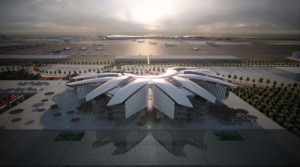In an appeal to draw in further trade and tourism, a series of Middle Eastern airports are in the process of being constructed and completed. According to an article recently published by CNN Travel, these airports, and the intention behind them, could be the future of air travel.
The article announces the completion of the Hamad International Airport in Doha, Quatar. The new terminal just started running on full operations this week, after a decade of construction—a project that was almost four years behind its projections. The delay in the project isn’t necessarily surprising, as it has resulted in a mammoth airport, with an annual capacity of fifty million passengers. The hub also includes a VIP terminal inspired by Arabian sailboats, an aquatic themed mosque and public space for art exhibitions. Physically, the building will eventually occupy just less than thirty square kilometers—approximately a third of the entirety of Doha city.
Hamad International Airport is only one of several upcoming air travel projects in the area. Due to the region’s growing wealth from oil and gas, communities are hoping they can draw on these funds and opportunities to increase trade and tourism. Naturally, the first step in that process is the construction of hubs that allow tourist to travel to their locale.
Two airports are now available in Dubai—the recently completed Dubai World Central and the Dubai International Airport. In Abu Dhabi, construction on the Midfield Terminal Complex is currently underway, with a set completion date in 2017. With this steady increase in terminals in the area, speculation has spread amongst analysts to debate whether the demands of trade and tourism can meet the supply of ports. While a definitive answer on this issue has yet to be found, some analysts believe that these terminals are perfectly placed to serve as a portal to the emerging markets of Asia and Africa.
